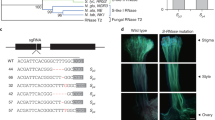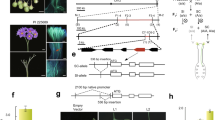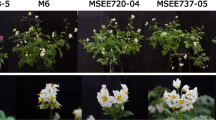Abstract
Potato is a heterozygous autotetraploid crop propagated as tubers. Diploid potatoes, which are mostly self-incompatible due to gametophytic self-incompatibility, are often used to reduce genetic complexity. The discovery of the S locus inhibitor (Sli) gene has created a way to develop diploid inbred lines and perform F1 hybrid breeding in potato. However, residual heterozygosity found in advanced-generation selfed progenies has posed the question of whether a minimum level of heterozygosity is necessary to maintain self-fertility. We continued selfing and finally identified a highly homozygous diploid potato among tenth-generation selfed progeny, which was homozygous at all 18,579 genome-wide single nucleotide polymorphism (SNP) markers surveyed. The S10 plants suffered severe inbreeding depression in terms of fertility and vigor, showing a small number of mature flowers and extremely slow growth. Although asexual techniques such as anther culture followed by chromosome doubling can result in completely homozygous diploid potatoes, all previously derived plants were male sterile. In contrast, continuous selfing using Sli swept out all lethal alleles and selected for self-fertility, which generated a highly homozygous diploid potato retaining male and female fertility and tuberization ability under long days.





Similar content being viewed by others
References
Akimoto K, Katakami H, Kim H-J, Ogawa E, Sano CM, Wada Y, Sano H (2007) Epigenetic inheritance in rice plants. Ann Bot 100:205–217
Bamberg J, Miller CJr (2012) Comparisons of ga1 with other reputed gibberellin mutants in potato. Am J Potato Res 89:142–149
Birhman RK (1986) Pollination mechanisms in Solanum chacoense. Acta Bot Indica 16:89–91
Birhman RK, Hosaka K (2000) Production of inbred progenies of diploid potatoes using an S-locus inhibitor (Sli) gene, and their characterization. Genome 43:495–502
Braun SR, Endelman JB, Haynes KG, Jansky SH (2017) Quantitative trait loci for resistance to common scab and cold-induced sweetening in diploid potato. Plant Genome 10:3
Cappadocia M, Cheng DSK, Ludlum-Simonette R (1986) Self- compatibility in doubled haploids and their F1 hybrids, regenerated via anther culture in self-incompatible Solanum chacoense Bitt. Theor Appl Genet 72:66–69
Charlesworth D, Willis J (2009) The genetics of inbreeding depression. Nat Rev Genet 10:783–796
Cho J, McCouch S, Kuiper M, Kang M-R, Pot J, Groenen J, Eun M (1998) Integrated map of AFLP, SSLP and RFLP markers using a recombinant inbred population of rice (Orysa sativa L.). Theor Appl Genet 97:370–380
Cipar MS, Peloquin SJ, Hougas RW (1964a) Inheritance of incompatibility in hybrids between Solanum tuberosum haploids and diploid species. Euphytica 13:163–172
Cipar MS, Peloquin SJ, Hougas RW (1964b) Variability in the expression of self-incompatibility in tuber-bearing diploid Solanum species. Am Potato J 41:155–162
Clot CR, Polzer C, Prodhomme C, Schuit C, Engelen CJM, Hutten RCB, van Eck HJ (2020) The origin and widespread occurrence of Sli-based self-compatibility in potato. Theor Appl Genet 133:2713–2728
De Jong H (1977) Self-compatibility in inbred cultivated diploid potatoes. Incompatibility Newsl 8:16–17
De Jong H, Rowe PR (1971) Inbreeding in cultivated diploid potatoes. Potato Res 14:74–83
de Vries M, ter Maat M, Lindhout P (2016) The potential of hybrid potato for East-Africa. Open Agr 1:151–156
Enciso-Rodriguez F, Manrique-Carpintero NC, Nadakuduti SS, Buell CR, Zarka D, Douches D (2019) Overcoming self-incompatibility in diploid potato using CRISPR-Cas9. Front Plant Sci 10:376
Endelman JB, Jansky SH (2016) Genetic mapping with an inbred line-derived F2 population in potato. Theor Appl Genet 129:935–943
Endelman J, Jansky SH, Butler N, Christensen G (2019) Genetic evidence of a recessive lethal allele on potato chromosome 12. Am J Potato Res 96:331
Golmirzaie AM, Ortiz R, Atlin GN, Iwanaga M (1998a) Inbreeding and true seed in tetraploid potato. I. Selfing and open pollination in Andean landraces (Solanum tuberosum Gp. Andigena). Theor Appl Genet 97:1125–1128
Golmirzaie AM, Bretschneider K, Ortiz R (1998b) Inbreeding and true seed in tetraploid potato. II. Selfing and sib-mating in heterogeneous hybrid populations of Solanum tuberosum. Theor Appl Genet 97:1129–1132
Gore MA, Chia JM, Elshire RJ, Sun Q, Ersoz ES, Hurwitz BL, Peiffer JA, McMullen MD, Grills GS, Ross-Ibarra J, Ware DH, Buckler ES (2009) A first-generation haplotype map of maize. Science 326:1115–1117
Hanneman REJr (1985) Self fertility in Solanum chacoense. Am Potato J 62:428–429
Haynes KG, Guedes ML (2018) Self-compatibility in a diploid hybrid population of Solanum phureja-S. stenotomum. Am J Potato Res 95:729–734
Hosaka K, Hanneman REJr (1998a) Genetics of self-compatibility in a self-incompatible wild diploid potato species Solanum chacoense. I. Detection of an S locus inhibitor (Sli) gene. Euphytica 99:191–197
Hosaka K, Hanneman REJr (1998b) Genetics of self-compatibility in a self-incompatible wild diploid potato species Solanum chacoense. 2. Localization of an S locus inhibitor (Sli) gene on the potato genome using DNA markers. Euphytica 103:265–271
Jansky SH, Chung YS, Kittipadukal P (2014) M6: a diploid potato inbred line for use in breeding and genetics research. J Plant Regist. https://doi.org/10.3198/jpr2013.05.0024crg
Jansky SH, Charkowski AO, Douches DS, Gusmini G, Richael C, Bethke PC, Spooner DM, Novy RG, De Jong H, De Jong WS, Bamberg JB, Thompson AL, Bizimungu B, Holm DG, Brown CR, Haynes KG, Sathuvalli VR, Veilleux RE, Miller JC Jr, Bradeen JM, Jiang J (2016) Reinventing potato as diploid inbred line-based crop. Crop Sci 56:1412–1422
Jones DF (1918) The effect of inbreeding and crossbreeding upon development. Proc Natl Acad Sci USA 4:246–250
Karp A, Risiott R, Jones MGK, Bright SWJ (1984) Chromosome doubling in monohaploid and dihaploid potatoes by regeneration from cultured leaf explants. Plant Cell Tiss Org Cult 3:363–373
Kimura T, Hosaka K (2002) Genetic mapping of a dwarfing gene found in Solanum phureja clone 1.22. Am J Potato Res 79:201–204
Kotch GP, Peloquin SJ (1987) A new source of haploid germplasm for genetic and breeding research. Am Potato J 64:137–141
Krantz FA (1924) Potato breeding methods. Minn Agric Exp Stn Tech Bull 25:1–32
Krantz FA (1946) Potato breeding methods. III. A suggested procedure for potato breeding. Techn Bull Minn Agric Exp Sta 173
Leisner CP, Hamilton JP, Crisovan E, Manrique-Carpintero NC, Marand AP, Newton L, Pham GM, Jiang J, Douches DS, Jansky SH, Buell CR (2018) Genome sequence of M6, a diploid inbred clone of the high-glycoalkaloid-producing tuber-bearing potato species Solanum chacoense, reveals residual heterozygosity. Plant J 94:562–570 (erratum: Plant J 96:482)
Lightbourn GJ, Veilleux RE (2007) Production and evaluation of somatic hybrids derived from monoploid potato. Am J Potato Res 84:425–435
Lindhout P, Meijer D, Schotte T, Hutten RCB, Visser RGF, van Eck HJ (2011) Towards F1 hybrid seed potato breeding. Potato Res 54:301–312
Marand AP, Jansky SH, Gage JL, Hamernik AJ, de Leon N, Jiang J (2019) Residual heterozygosity and epistatic interactions underlie the complex genetic architecture of yield in diploid potato. Genetics 212:317–332
McMullen M, Kresovich S, Villeda H, Bradbury P, Li H, Sun Q, Flint-Garcia S, Thornsberry J, Acharya C, Bottoms C, Brown P, Browne C, Eller M, Guill K, Harjes C, Kroon D, Lepak N, Mitchell SE, Peterson B, Pressoir G, Romero S, Rosas MO, Salvo S, Yates H, Hanson M, Jones E, Smith S, Glaubitz JC, Goodman M, Ware D, Holland JB, Buckler ES (2009) Genetic properties of the maize nested association mapping population. Science 325:737–740
Meijer D, Viquez-Zamora M, van Eck HJ, Hutten RC, Su Y, Rothengatter R, Visser RGF, Lindhout WH, van Heusden AW (2018) QTL mapping in diploid potato by using selfed progenies of the cross S. tuberosum × S. chacoense. Euphytica 214:121
Mendiburu AO, Peloquin SJ (1977) Bilateral sexual polyploidization in potatoes. Euphytica 26:573–583
Meyer R, Salamini F, Uhrig H (1993) Isolation and characterization of potato diploid clones generating a high frequency of monohaploid or homozygous diploid androgenetic plants. Theor Appl Genet 85:905–912
Miura K, Agetsuma M, Kitano H, Yoshimura A, Matsuoka M, Jacobsen SE, Ashikari M (2009) A metastable DWARF1 epigenetic mutant affecting plant stature in rice. Proc Natl Acad Sci USA 106:11218–11223
M’Ribu HK, Veilleux RE (1990) Effect of genotype, explant, subculture interval and environmental conditions on regeneration of shoots from in vitro monoploids of a diploid potato species, Solanum phureja Juz. & Buk.. Plant Cell Tiss Org Cult 23:171–179
Nakamura S, Hosaka K (2010) DNA methylation in diploid inbred lines of potatoes and its possible role in the regulation of heterosis. Theor Appl Genet 120:205–214
Olsder J, Hermsen JGTh (1976) Genetics of self-compatibility in dihaploids of Solanum tuberosum L. 1. Breeding behaviour of two self-compatible dihaploids. Euphytica 25:597–607
Pandey KK (1962) Interspecific incompatibility in Solanum species. Amer J Bot 49:874–882
Paz MM, Veilleux RE (1999) Influence of culture medium and in vitro conditions on shoot regeneration in Solanum phureja monoploids and fertility of regenerated doubled monoploids. Plant Breed 118:53–57
Peterson BA, Holt SH, Laimbeer PE, Doulis AG, Coombs J, Douches DS, Hardigan MA, Buell CR, Veilleux RE (2016) Self-fertility in a cultivated diploid potato population examined with the Infinium 8303 potato single-nucleotide polymorphism array. Plant Genome 9:3
Phumichai C, Hosaka K (2006) Cryptic improvement for fertility by continuous selfing of diploid potatoes using Sli gene. Euphytica 149:251–258
Phumichai C, Mori M, Kobayashi A, Kamijima O, Hosaka K (2005) Toward the development of highly homozygous diploid potato lines using the self-compatibility controlling Sli gene. Genome 48:977–984
Phumichai C, Ikeguchi-Samitsu Y, Fujimatsu M, Kitanishi S, Kobayashi A, Mori M, Hosaka K (2006) Expression of S-locus inhibitor gene (Sli) in various diploid potatoes. Euphytica 148:227–234
Pushkarnath (1942) Studies on sterility in potatoes. 1. The genetics of self- and cross-incompatibilities. Indian J Genet Pl Breed 2:11–36
Ross H (1986) Potato breeding-problems and perspectives. Verlag Paul Parey, Berlin
Sanetomo R, Akino S, Suzuki N, Hosaka K (2014) Breakdown of a hybridization barrier between Solanum pinnatisectum Dunal and potato using the S locus inhibitor gene (Sli). Euphytica 197:119–132
Saze H, Kakutani T (2007) Heritable epigenetic mutation of a transposon-flanked Arabidopsis gene due to lack of the chromatin-remodeling factor DDM1. EMBO J 26:3641–3652
Sharma SK, MacKenzie K, McLean K, Dale F, Daniels S, Bryan GJ (2018) Linkage disequilibrium and evaluation of genome-wide association mapping models in tetraploid potato. G3 8:3185–3202
The Potato Genome Sequencing Consortium (2011) Genome sequence and analysis of the tuber crop potato. Nature 475:189–195
Uijtewaal BA, Jacobsen E, Hermsen JGTh (1987) Morphology and vigour of monohaploid potato clones, their corresponding homozygous diploids and tetraploids and their heterozygous diploid parent. Euphytica 36:745–753
Ye M, Peng Z, Tang D, Yang Z, Li D, Xu Y, Zhang C, Huang S (2018) Generation of self-compatible diploid potato by knockout of S-RNase. Nat Plants 4:651–654
Zhang C, Wang P, Tang D, Yang Z, Lu F, Qi J, Tawari NR, Shang Y, Li C, Huang S (2019) The genetic basis of inbreeding depression in potato. Nat Genet 51:374–378
Acknowledgements
We thank late Dr. R. K. Birhman and Dr. C. Phumichai for their contributions to this long-term experiment. This research was supported partly by a JSPS Grant-in-Aid for Scientific Research (C) (Grant Number JP19K05962) and by Calbee Inc., Hokkaido Potato Growers Association, Kewpie Corp., KENKO Mayonnaise Co., Ltd., and the Japan Snack Cereal Foods Association.
Author information
Authors and Affiliations
Contributions
KH and RS carried out the crossing experiment. KH conducted SNP analysis and wrote the manuscript. All authors read and approved the final manuscript.
Corresponding author
Ethics declarations
Conflict of interest
The authors declare that they have no conflict of interest.
Electronic supplementary material
Below is the link to the electronic supplementary material.
Rights and permissions
About this article
Cite this article
Hosaka, K., Sanetomo, R. Creation of a highly homozygous diploid potato using the S locus inhibitor (Sli) gene. Euphytica 216, 169 (2020). https://doi.org/10.1007/s10681-020-02699-3
Received:
Accepted:
Published:
DOI: https://doi.org/10.1007/s10681-020-02699-3




